ISRO Dispatches Crew Module for Gaganyaan’s First Uncrewed Mission
On 21 January 2025, the Liquid Propulsion Systems Centre (LPSC) of ISRO dispatched the Crew Module for the Gaganyaan (G1) mission. This marks a significant milestone in India’s first human spaceflight programme. The module, intended for the mission’s first uncrewed test flight, successfully integrated its liquid propulsion system at LPSC.
ISRO Advanced Propulsion for Precision Control
The Crew Module Propulsion System (CMPS) is a state-of-the-art bi-propellant Reaction Control System (RCS). It ensures precise three-axis control (Pitch, Yaw, and Roll) during the descent and re-entry phases. This control mechanism activates after the service module separates and operates until the deployment of the parachute-based deceleration system.
Key features of the system include:
- 12 Thrusters: Each delivering a thrust of 100 Newtons.
- Pressurisation System: Equipped with high-pressure gas bottles.
- Propellant Feed System: Supporting efficient fluid control components.
Integration of the Uprighting System
The Crew Module Uprighting System (CMUS), developed by the Vikram Sarabhai Space Centre (VSSC), has also been integrated into the module at LPSC. This system ensures the module remains upright after landing, enhancing recovery and safety procedures.
Final Integration Steps
Following its dispatch, the Crew Module will undergo further assembly and testing at VSSC. Key operations include integrating the avionics package, electrical harnessing, and conducting comprehensive checks. After this phase, the module will be sent to the U R Rao Satellite Centre in Bangalore. There, the final integration with the Orbital Module will take place, completing preparations for the G1 mission.
Gaganyaan represents a significant leap in India’s space capabilities. By advancing human space exploration, it underscores ISRO’s commitment to achieving excellence in science and technology.





